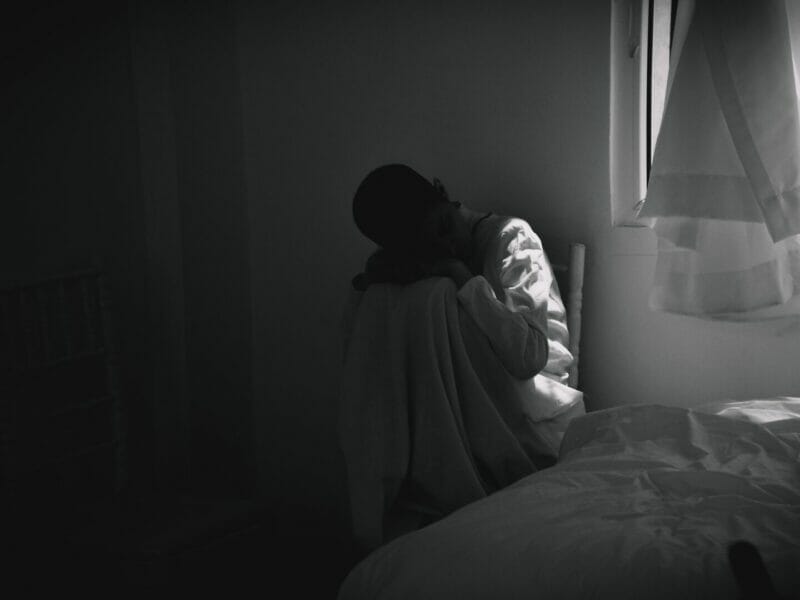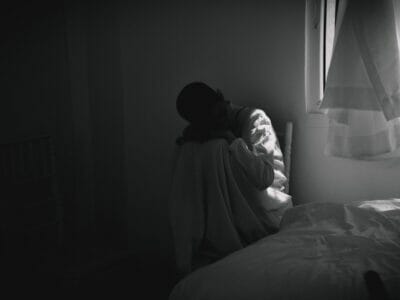What is Non-24-Hour Sleep-Wake Disorder?
Non-24-Hour Sleep-Wake Disorder (N24SWD) is a sleep disorder that affects the circadian rhythm, or the body’s natural sleep-wake cycle. It is a condition in which the body’s internal clock is out of sync with the 24-hour day-night cycle. People with N24SWD experience difficulty sleeping at night and staying awake during the day. According to the American Academy of Sleep Medicine, N24SWD is the most common circadian rhythm disorder.
People with N24SWD have difficulty maintaining a regular sleep-wake schedule. They may experience delayed sleep onset, meaning they have difficulty falling asleep at night, and difficulty waking up in the morning. They may also experience irregular sleep-wake rhythm disorder, meaning their sleep-wake cycle is longer or shorter than 24 hours. People with N24SWD may also experience delayed sleep phase disorder, meaning their sleep onset time is delayed by several hours.
Treatment for N24SWD can include melatonin treatment, a melatonin receptor agonist, or a combination of both. According to the Sleep Foundation, melatonin may be effective in stabilizing the sleep-wake cycle in people with N24SWD. However, there are still many diagnostic and treatment challenges for people with N24SWD, especially those with sighted non-24-hour sleep-wake rhythm disorder. Treatment options exist, but the efficacy of melatonin and other treatments is still being studied.
What is Melatonin and How Does it Relate to Non-24-Hour Sleep-Wake Disorder?
Melatonin is a hormone that is naturally produced in the body and is responsible for regulating the body’s circadian rhythm. It is especially important for people with Non-24-Hour Sleep-Wake Disorder (N24SWD), a circadian rhythm disorder that causes a person’s sleep-wake cycle to be longer than 24 hours. People with N24SWD often experience difficulty falling asleep and staying asleep, as well as difficulty waking up in the morning.

Melatonin can be used to help treat N24SWD by helping to reset the body’s circadian rhythm. It is typically taken in the form of a supplement, usually in a dose of melatonin between 0.3 and 5 mg, taken one to two hours before the desired sleep time. Studies have shown that melatonin can be effective in helping to entrain the body to a 24-hour sleep-wake cycle, as well as in improving sleep duration and quality.
It can also be used in combination with other treatments, such as light therapy, to help treat N24SWD in sighted and non-sighted patients. Treatment guidelines for sighted and non-sighted patients with N24SWD recommend melatonin as a first-line treatment for the disorder.
The Sleep Foundation Score™ and Non-24-Hour Sleep-Wake Disorder
The Sleep Foundation Score™ is a tool used to diagnose and treat Non-24-Hour Sleep-Wake Disorder (N24SWD). This disorder is a circadian rhythm sleep disorder that affects the timing of sleep and wake cycles. It is characterized by a delayed sleep-wake phase disorder, which means that the patient’s sleep-wake cycle is out of sync with the 24-hour cycle of the day. This can lead to difficulty falling asleep and staying asleep, as well as difficulty waking up in the morning.
The Sleep Foundation Score™ is used to assess the severity of the disorder and to determine the best treatment plan. It includes a sleep diary, which records the patient’s sleep and wake times, as well as a questionnaire to assess the patient’s sleep pattern. The score also takes into account the patient’s melatonin secretion and circadian rhythm sleep disorders network. It is used to diagnose and treat N24SWD in both sighted and non-sighted patients, as well as to diagnose and treat other sleep disorders such as obstructive sleep apnea syndrome, advanced sleep phase, and sleep-wake cycle disturbance.
Treatment challenges of N24SWD include entrainment to a 24-hour cycle, sleep deprivation, and treatment with melatonin. Melatonin is often used to help reset the body’s sleep-wake cycle and can be taken in doses of up to 10 mg per day. The Sleep Foundation Score™ is an important tool in the diagnosis and treatment of N24SWD and other sleep disorders, and can help patients with circadian rhythm sleep disorders get the treatment they need.
Treatment Options for Non-24-Hour Sleep-Wake Disorder
Non-24-Hour Sleep-Wake Disorder is a chronic sleep-wake syndrome that affects sighted and non-sighted individuals. It is characterized by a disruption in the circadian rhythm of sleep and wake, resulting in a delayed sleep-wake phase disorder and sighted non-24-hour sleep-wake cycles. Treatment of this disorder can be challenging, as it requires a combination of lifestyle changes, medications, and therapies.
Melatonin is one of the most commonly used treatments for Non-24-Hour Sleep-Wake Disorder. It is a hormone that helps regulate the body’s circadian rhythm of sleep and wake. Studies have shown that taking 3-6 mg of melatonin at bedtime can help improve the timing of the sleep-wake cycle and reduce the duration of sleep. Additionally, melatonin has been found to have an effect in the treatment of insomnia and other sleep disorders.
Other treatments for Non-24-Hour Sleep-Wake Disorder include light therapy, cognitive behavioral therapy, and medications such as sleep aids and antidepressants. According to the International Classification of Sleep Disorders, treatment of Non-24-Hour Sleep-Wake Disorder should be tailored to the individual patient’s needs. The Circadian Sleep Disorders Network and the Sleep Medicine Reviews suggest that patients with Non-24-Hour Sleep-Wake Disorder should be evaluated by a sleep specialist to determine the best treatment plan.
The Impact of Non-24-Hour Sleep-Wake Disorder on Sleep Quality
Non-24-Hour Sleep-Wake Disorder (Non-24) is a chronic sleep-wake disorder that affects the body’s ability to regulate its sleep-wake cycle. It is most commonly seen in people who are blind or have autism spectrum disorder, but can also affect sighted people. People with Non-24 experience a disruption in their circadian melatonin rhythm, which can lead to difficulty falling asleep and staying asleep. This can have a significant impact on sleep quality, leading to daytime fatigue, difficulty concentrating, and irritability.
Treatment challenges of Non-24 in sighted people can be difficult due to the complexity of the disorder. For example, delayed sleep phase syndrome (DSPS) is a common disorder in sighted people that can be mistaken for Non-24. It is important to differentiate between the two in order to provide the most effective treatment. Melatonin on the free-running circadian rhythm is often used to help regulate the sleep-wake cycle in Non-24 disorder patients.
Additionally, establishing a consistent bedtime and wake time can help to improve the quality of sleep. However, due to the complexity of the disorder, treatment challenges remain for both sighted and non-sighted people. Sleep Med Clin. 2020 Mar;15(2):179-188. doi: 10.1016/j.jsmc.2019.10.004. Epub 2019 Nov 8. PMID: 31709845.

Conclusion
Sleep and wake cycles are essential for the body to function properly. Non-24-hour sleep-wake disorder is a condition in which a person’s sleep-wake cycle does not match the 24-hour day-night cycle. This disorder is more common in people who are blind, but it can also affect sighted people.
Treatment challenges of non-24-hour sleep-wake disorder in sighted people are due to the difficulty in recognizing the disorder and the lack of knowledge about the condition.
The main symptom of non-24-hour sleep-wake disorder is difficulty sleeping and staying awake at the same time each day. This can lead to excessive daytime sleepiness, difficulty concentrating, and mood changes. People with this disorder may also experience difficulty sleeping at night and difficulty waking up in the morning.
The cause of non-24-hour sleep-wake disorder is not known, but it is believed to be related to the body’s internal clock, or circadian rhythm. This internal clock is responsible for regulating the body’s sleep and wake cycles. In people with non-24-hour sleep-wake disorder, the body’s internal clock is not in sync with the 24-hour day-night cycle.
Treatment for non-24-hour sleep-wake disorder in sighted people is challenging due to the difficulty in recognizing the disorder and the lack of knowledge about the condition. Treatment options include light therapy, melatonin, and lifestyle changes. Light therapy is used to reset the body’s internal clock, while melatonin helps to regulate the body’s sleep-wake cycle. Lifestyle changes such as avoiding caffeine and alcohol, exercising regularly, and maintaining a consistent sleep schedule can also help to regulate the body’s sleep-wake cycle.
In conclusion, non-24-hour sleep-wake disorder is a condition in which a person’s sleep-wake cycle does not match the 24-hour day-night cycle. This disorder is more common in people who are blind, but it can also affect sighted people. Treatment challenges of non-24-hour sleep-wake disorder in sighted people are due to the difficulty in recognizing the disorder and the lack of knowledge about the condition. Treatment options include light therapy, melatonin, and lifestyle changes. It is important to recognize the symptoms of non-24-hour sleep-wake disorder and seek treatment in order to maintain healthy sleep and wake cycles.

FAQ’s:
Q1. What is non-24-hour sleep-wake disorder?
A1. Non-24-hour sleep-wake disorder is a sleep-wake disorder in which a person’s body does not follow a 24-hour sleep-wake cycle, resulting in difficulty sleeping and staying awake at regular times.
Q2. What are the treatment challenges of non-24-hour sleep-wake disorder in sighted people?
A2. Treatment challenges of non-24-hour sleep-wake disorder in sighted people include finding the right balance of light exposure and melatonin to help regulate the body’s sleep-wake cycle.
Q3. How does melatonin help with non-24-hour sleep-wake disorder?
A3. Melatonin helps with non-24-hour sleep-wake disorder by helping to regulate the body’s sleep-wake cycle and allowing for more regular hours of sleep.
Q4. What are the effects of non-24-hour sleep-wake disorder on sleep and circadian rhythms?
A4. Non-24-hour sleep-wake disorder can disrupt sleep and circadian rhythms, resulting in difficulty sleeping and staying awake at regular times.
Q5. How can non-24-hour sleep cycles be managed?
A5. Non-24-hour sleep cycles can be managed by finding the right balance of light exposure and melatonin to help regulate the body’s sleep-wake cycle.



 Modafinil For Managing Fatigue
Modafinil For Managing Fatigue
